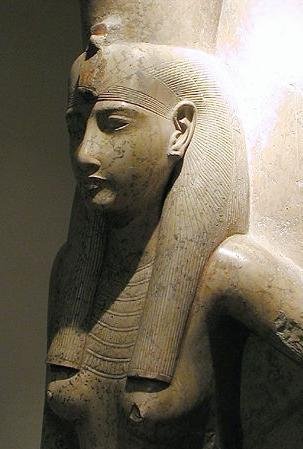Egyptian Goddess Mut – Origin Story, Family, Symbol, & Importance
Ancient Egyptian goddess Mut was worshiped as the mother goddess of the Egyptian pantheon. Like many Egyptian deities, Mut’s attributes and roles changed over the millennia. In some ancient texts, she was revered as the goddess who gave life to everything in the world. In another instance, she never gave birth per se; instead she adopted the moon god Khonsu as her son.
Who was the goddess Mut?
Goddess of: Sky, protection, and motherhood
Father: Ra
Consort: Amun-Ra
Siblings: Sekhmet, Bastet, Ma’at, Hathor
Son: Khonsu
Most famous temple: Karnak, Thebes
Symbol: Vulture, lioness, the Uraeus (a rearing cobra), a cat
Other names: Mout, Maut
Epithets: Lady of Heaven, Mistress of All the Gods, The Embodiment of Ka. World-Mother
Festivals: Opet Festival and the Beautiful Festival of the Valley
Origin story and the meaning of her name
Mut’s name in ancient Egypt means “mother”. In both the Middle Kingdom (c. 2040 – c. 1640 B.C.E) and the New Kingdom (c. 1552 – c. 1070 B.C.E), it was commonly held that she was the spouse of Amun (the creator god and patron god of Egyptian pharaohs).
As a primordial deity, Mut was also associated with the primordial waters of Nu (an oceanic abyss). In some ancient Egyptian texts, everything that is in the world emerged from that watery mass of chaos kind courtesy of Mut. What this means is that Mut had no mother or father.
Creation of the gods and universe
Upon her emergence from Nu (Nun), Mut proceeded to give birth to the first gods of the world. It is for this reason she is sometimes known as She Who Gives Birth or Mother of the Gods. Other accounts state that she did not give birth to any children; rather, she adopted two gods – Khonsu (the god of the moon) and Menthu (the god of war).
According to some accounts, Mut is believed to have emerged from the Nile River. The sun god Ra was sometimes seen as her father. And if that were the case, the likes of Bastet, Hathor and Sekhmet would be her siblings. This would also mean that her epithet, Eye of Ra, is not misplaced. She picked up this epithet after the god Amun merged with Ra.
READ MORE: Three Major Time Periods of Ancient Egypt
Depictions, symbols and epithets
In most depictions of her, she can be seen elegantly dressed with a double crown of the Egyptian pharaohs on her head. This symbolizes her complete dominion over the two lands of Egypt – Upper and Lower Egypt. Affixed to the crown is often the feather of Ma’at, the Egyptian goddess of truth, law and order. To reinforce her life-giving properties, she is depicted holding the ankh – the Egyptian symbol of life.
In some cases”, Mut has been depicted as a cat, a cow or a lioness. There have also been depictions of her as a vulture or a cobra.
Due to the double crown that she wears, some of her followers considered her as the “Lady of Heaven”. This epithet of hers could mean that she might have been seen as a sky goddess in ancient Egypt.
Other epithets of hers include: Eye of Ra, Mistress of all the Gods, and Embodiment of Ka. In the latter, the term “Ka” refers to vital essence of the soul that is kept alive using food and drink.
Worship and temples of Egyptian goddess Mut
The goddess Mut’s worship did not become widespread until around the Middle Kingdom. Prior to that, deities such as Amaunet (Amunet) and Wosret occupied her position in the pantheon.
Mut’s worship was particularly famous in the Upper Egyptian city of Thebes, which was also the religious hub of ancient Egypt. Both she and Amun were worshiped as patron deities of the city.
The famous Theban Triad (or the Triad of Waset) in Egypt’s capital city referred to Mut, her son Khonsu, and her husband Amun. The most famous religious temples of Mut in the city were located in Karnak.
In what is now modern-day Sudan, followers of Mut worshiped her at a temple called Temple of Jebel Barkal.
Additionally, some parts of Upper Egypt regarded her as a lioness deity. With such depictions, it explains why Mut was sometimes associated with the ferocious Lower Egyptian deity Sekhmet.
READ MORE:
Other Interesting facts about the goddess Mut
- During the reign of Pharaoh Hatshepsut in the Eighteenth Dynasty, several temples and structures were built in honor of the goddess Mut. The pharaoh’s actions helped popularize Mut’s worship across the land.
- In order to stamp her divine authority as pharaoh of Egypt, Hatshepsut started the custom of showing Mut wearing the united crowns of Egypt (Upper Egypt and Lower Egypt). This was also another way of reinforcing the notion that she was the Queen of the Goddess.
- Such was Mut’s importance that her temple (Temple of Mut) received regular maintenance during the Ptolemaic era (c. 305 – 30 BC) in ancient Egypt.
- Mut’s worship (as well as the worships of other deities) dwindled during the reign of the “heretic” pharaoh Akhenaten (also known as Amenhotep IV). However, it bounced back in the subsequent dynasties. For example, the likes of Seti I and Ramesses the Great (Ramesses II) (c. 1303-1213) of the Nineteenth Dynasty reinvigorated Mut’s worship.

19th Dynasty Pharaoh Ramesses II (c. 1303-1213) was an ardent follower of the goddess Mut






























This helps me a lot with school